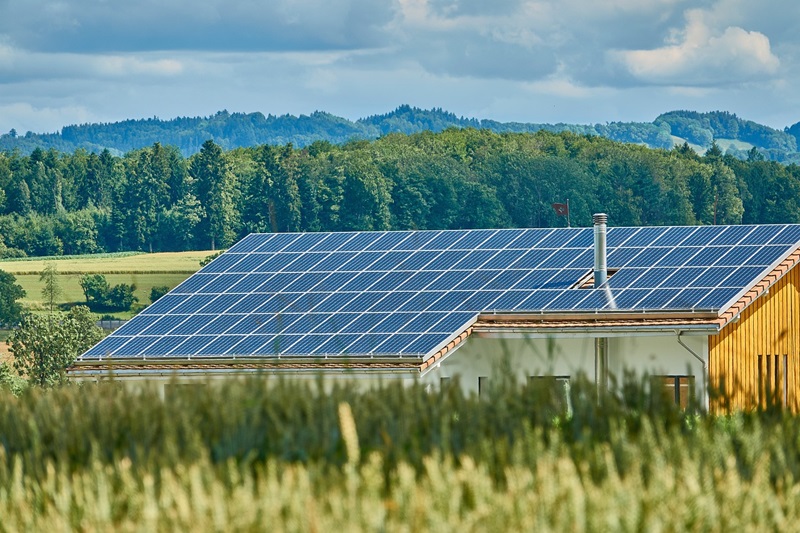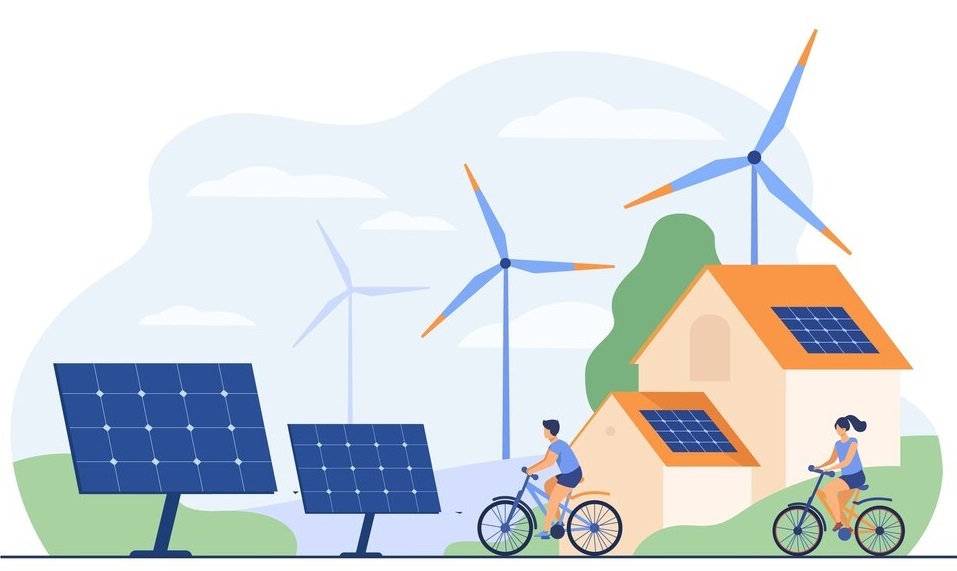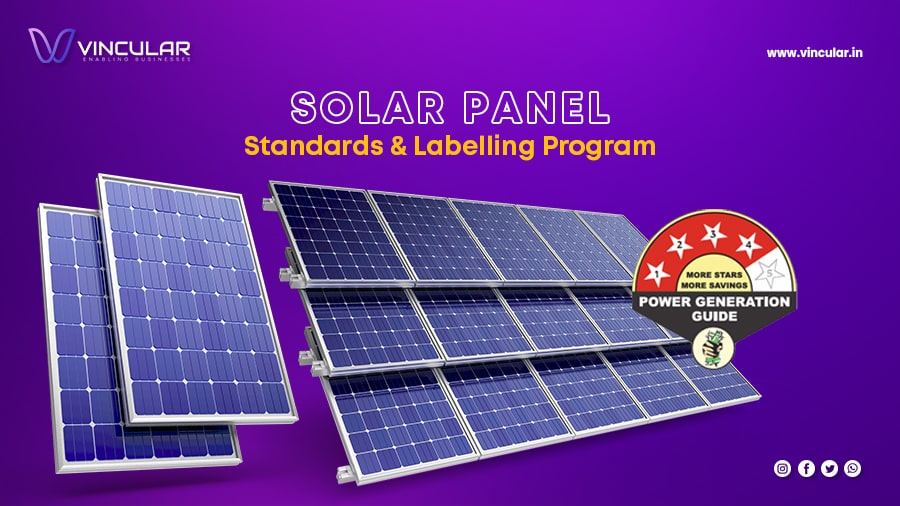Recently, the government of India has launched a Standards and Labeling Programme for solar panel or solar photovoltaic (PV) modules, which allows citizens to check their efficiency.
The Scheme was initiated by Shri R. K. Singh the the Union Minister for Power and New & Renewable Energy in New Delhi on 20 October 2023.
The Bureau of Energy Efficiency’s (BEE) star labelling scheme for PV modules applies from 1st January 2024 to 31st December 2025. There is no labelling fee for this period.
The proposed performance standards will provide customers with a better understanding of the costs and energy savings associated with the use of solar panels.
Now, let’s understand the objective of solar panel standards and labelling schemes.
Objective of Solar Panel Standard and Labelling Scheme

This scheme is part of the government’s larger objective of increasing the proportion of renewable energy sources and reducing the carbon footprint of GDP by 45% by 2030.
Furthermore, the government’s goal is to increase the adoption of solar rooftops and encourage consumers to play an important role in reducing carbon footprints by around 58 million tonnes annually.
Likewise, citizens have no clue which product is good. So, this scheme aims to provide consumers with essential information to help them choose efficient solar panels.
Additionally, the Star Labelling Programme will also help consumers differentiate among various solar panel models and make informed choices.
Advantages of Star Labelling Program for Solar Panel

You’ve heard about the star labelling program for solar panels, but you’re still unsure what the buzz is about. Let’s take a look at the benefits of the solar panel star labelling program.
1. Increases Transparency
If you want to get more people to install solar on their roofs, you need to educate them on the best solar panels for their needs.
As a result, the introduction of a star labelling program for solar panels will help citizens gain a better understanding of the efficiency and performance of solar panels, thus allowing them to make better decisions.
Further, it makes it easier for citizens to choose solar modules by their budgets and needs.
2. Lower Energy Bills by Installing Solar Panel
Higher-efficiency solar panels generate more electricity per unit of sunlight, resulting in lower electricity bills for consumers with star-rated panels.
3. Enhance Efficiency and Environmental Impact
Star labelling program focuses on improving the efficiency of Solar PV modules by 2% over existing levels.
Furthermore, the increased efficiency is expected to increase electricity generation by 33GWh per year.
Upgrading from a 1-Star to a 2-Star solar panel on a typical 10 square-meter roof area could result in around a 12% increase in electricity generation.
This efficiency can contribute to reducing the overall environmental impact by generating more electricity from the natural source.
4. Reduce Carbon Dioxide Emissions
Shri Singh indicated that our Star Labeling program is unrivalled in the world.
Just three or four BEE programs have collectively reduced carbon dioxide emissions by over 300 million tonnes annually, or about 58 million Tonnes of CO2 less per year.
According to estimates, by 2030, enabling solar panels to produce energy will cut carbon dioxide emissions by 30 million tons annually.
This is critical to the survival of both the earth and humankind.
5. Create New Opportunities by Promoting 100% Indian-Made Panels
The government will strive to produce the highest-quality solar PV modules that are 100% Made in India. PV Cells be produced in India rather than being imported.
Union Minister said “We will demand that wafers be produced in India after an additional two years to produce high-quality, 100% Indian-made solar panels, starting with the cells and eventually including the wafers.
However, India demands the best; we will not accept anything less. The Approved List of Models and Manufacturers (ALMM) will gradually remove less efficient panels; old models won’t”.
6. Expansion of Solar Panel Rooftops
Expanding rooftop solar energy use is a government goal, as the Minister of State for Energy and Mineral Resources states.
At the G20 Summit, which was held under the Indian Presidency, leaders pledged to “Double Energy Efficiency by 2030.”
Consequently, India launched its Standards and Labelling Program, allowing the nation to minimize its carbon footprint by about 58 million tons a year.
India is also in the driving seat of the global solar energy grid deployment. So, the government aims to expand the investment in solar roofs and the purchasing public is key to this endeavor.
7. Increasing Awareness and Promoting Renewable Energy
The standards and labelling program are critical to raising awareness of the benefits of solar energy and providing transparency to people interested in installing solar panels.
It is likely that the more informed the citizens are, the more likely they are to use solar power, thereby reducing carbon dioxide emissions, which will benefit the environment.
Testing Parameter of Solar Panels
Below are some testing parameters which need to be performed for this product:
- Hot-spot endurance test
- UV preconditioning
- Thermal cycling test
- Humidity freeze test
- Damp heat test
The design qualification tests must be conducted by the following:
| Crystalline silicon PV modules | IS 14286: 2010/ IEC 61215: 2005 |
| Thin film PV modules | 16077: 2013/ IEC 61646: 2008 |
The performance of solar PV modules must not degrade beyond 3% post the PID (Potential induced degradation) test.
Moreover, the modules must be tested for PID as per IS 17210 (Part 1): 2019.
Significance of Properly Labeling Solar-Powered Systems

It is essential to keep in consideration that installing or maintaining a solar-powered system involves electrical work that carries a degree of danger.
Since this kind of system has a few extra parts, there will be more areas that might require attention, which implies more possible locations for labelling.
Considering where labels should belong and applying them to your surroundings is well worth the effort.
Let’s start by finding out more about the significance of labelling solar-powered installations:
- Electrical safety labelling is an important part of the electrical safety process. When a solar-powered system is correctly labelled, anyone working in the area of the system will be made aware of the risks associated with it.
For instance, each component of a solar system that is receiving power needs to be labelled with information on the voltage level and other risk factors.
- Another good reason for labelling your solar equipment is to make sure that it’s easy and accurate to work on. It doesn’t matter who’s working on your system as long as the individual parts are labelled in advance.
This is particularly important when you’re dealing with maintenance that needs to be done outside of the team that installed it.
- It makes perfect sense to label solar panel systems and any electrical system. It’s a simple and cost-effective way to ensure that all the necessary information is easily accessible.
- Several regulations apply to electrical equipment, so in some cases, you may need to have the labels installed correctly.
Get BEE Certification Hassel-Free with Vincular 
If you are looking for BEE Certification then Vincular is the best compliance solution provider for energy efficiency excellence.
Since 2016, we have been working with manufacturers across the globe to get the BEE certificate in the minimal possible timeline that can give you a competitive edge in the market.
Note- To stay up-to-date with the latest regulations and notifications watch our Publication space or subscribe to our WhatsApp channel.
Conclusion
The surge in the attractiveness of photovoltaic solar panels has already taken place and will continue to occur.
Since we have a comprehensive strategy to address climate change, we anticipate installing at least 200 GW more solar panels before 2030. The core of the program is effective efficiency.
The efficiency of solar PV modules is predicted to increase by 2% over the present scenario. A yearly boost in electricity generation of 33GWh will be expected due to performance improvement, mitigating about 27,000 tons of CO2 emissions.
Currently on hand 19 appliances are in the voluntary regime, where the market is still in its beginning stages, and 15 appliances are in the mandatory regime, meaning they cannot be sold in the market without the label.
The primary objective of this program is twofold; firstly, it aims to establish performance standards that will enable customers to have a clear understanding of the cost savings and energy efficiency of solar panels.
Secondly, it aligns with the government’s broader commitment to enhancing the share of renewable energy and reducing the emission intensity of GDP by 45% by 2030.




